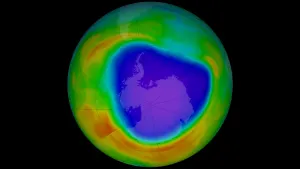
250 million years ago, our planet smelled like rotten eggs
"Toxic microbe burps caused a mass extinction," the study's authors say.
The Earth wasn't a hospitable place 250 million years ago. Siberian volcanoes were spouted greenhouse gases that caused Earth to warm, leading to the extinction of 80 per cent of marine species along with many animals on land.
And it turns out it was a smelly place too, researchers at UC Riverside say in a new paper appearing in the journal Nature Geoscience. In it, scientists explain how the warming caused such widescale deaths and the stinky side effects.
It turns out the heat sped up the metabolisms of microbes, creating a chain of events that led to toxic sulphide filling the air.
"As ocean photosynthesizers -- the microbes and plants that form the base of the food chain -- rotted, other microbes quickly consumed the oxygen and left little of it for larger organisms. In the absence of oxygen, microbes consumed sulphate then expelled toxic, reeking hydrogen sulfide, or H2S, creating an even more extreme condition called euxinia," the authors of the paper said in a statement.
"These conditions were sustained by the release of nutrients during decomposition, promoting the production of more organic material which helped to maintain this stinky, toxic cycle."
The research shows the entire ocean wasn't euxinic - rather, those conditions began in the deep.
"As temperatures increased, the euxinic zones got larger, more toxic, and moved up the water column into the shelf environment where most marine animals lived, poisoning them," UC Riverside Earth system modeler Dominik Hülse said.
Chemical signatures in sediment samples were used to detect the expanding euxinic zones.
The authors hope the findings will help researchers better understand how warming waters impact our climate.
While rare, euxinic waters can still be found on Earth, accounting for less than 0.5 per cent of the modern-day sea floor.
In September 2021, euxinic waters occurred in Los Angeles County's 16-mile-long Dominguez Channel following a warehouse fire that released ethanol into the water.
The ethanol killed the vegetation in the water, which was consumed by microbes when it decayed. The microbes then produced toxic levels of hydrogen sulphide.
People near the channel reported vomiting, headaches, sneezing, dizziness, and diarrhea following the event.
Officials neutralized the odour with biodegradable materials. They also added oxygen to the wastewater to halt the excessive production of hydrogen sulphide.
Thumbnail created by Cheryl Santa Maria. Eggs: phodopus/Canva Pro Background: CasPhotography/Getty Images










